Exploring the Velociraptor Skull Replica: A Comprehensive Guide

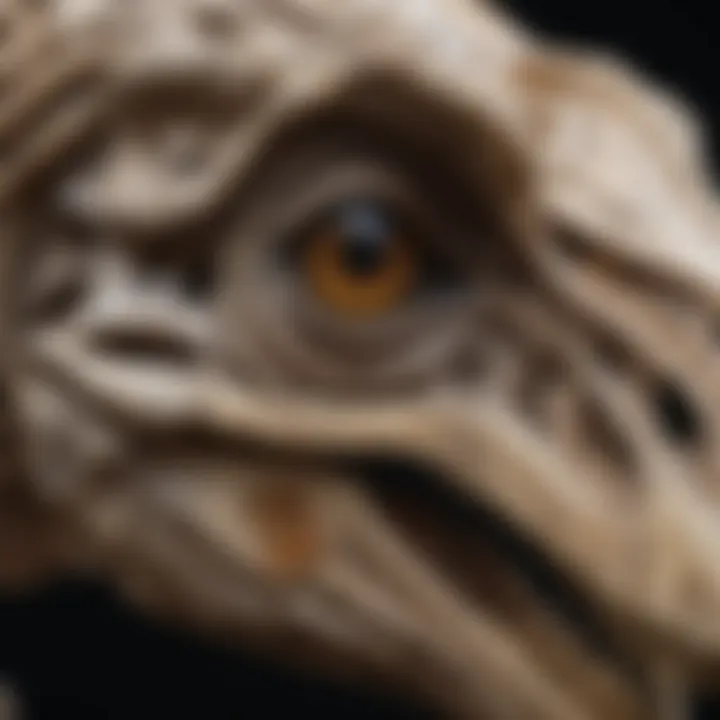
Intro
The velociraptor skull replica serves as both a fascinating collectible and a vital educational tool in paleontology. Understanding the details surrounding these replicas can significantly enhance a collector's knowledge and appreciation. From their anatomical features to the production methods employed, each aspect of the velociraptor skull replica offers insight into its significance in the broader context of fossil collecting. As you delve deeper into this guide, you will discover various components that make these skulls unique and valuable.
Featured Collectible of the Month
Overview
The velociraptor, known for its agility and cunning, has captured the imagination of enthusiasts worldwide. This month, we focus on the skull replica as a highlight of collectible items. These replicas reproduce the unique features of the velociraptor skull, making them essential for both collectors and educators.
Historical Significance
The velociraptor, which lived around 75 million years ago during the Late Cretaceous period, gained fame not just through scientific advancements but also through cinematic representations. Though the films often exaggerate its size and behavior, real-life velociraptors were much smaller and covered in feathers. The skull replica promotes an understanding of these creatures and their ecological contexts. Collectors value these replicas for their ability to connect modern audiences with ancient life forms.
Identification Techniques
Visual Characteristics
Identifying a velociraptor skull replica requires attention to several key visual cues. A genuine replica should display:
- Cranial structure that mimics the actual dimensions of the velociraptor skull.
- Detailing of teeth which should reflect the species' carnivorous nature.
- Surface texture resembling the fossilized look of real bones.
A careful examination of these details can aid collectors, helping them discern higher-quality replicas from lesser ones.
Resources for Identification
Several resources can assist in accurately identifying velociraptor skull replicas:
- Online forums like Reddit provide discussions among knowledgeable collectors.
- Educational websites such as Encyclopædia Britannica offer information about the evolution and characteristics of velociraptors.
- Museums often have displays that feature both real fossils and replicas, providing an opportunity for side-by-side comparisons.
By using these resources, collectors can deepen their understanding and enhance their collections.
"Understanding the details and characteristics of velociraptor skulls not only enriches the collecting experience but also fosters a greater appreciation for paleontology itself."
As we progress through this guide, you will find more about the production methods and the educational value these velociraptor skull replicas hold for both aspiring and seasoned collectors.
Preamble to Velociraptor Skull Replicas
The study of dinosaur fossils has captivated not just paleontologists, but also collectors and enthusiasts. Among these fossils, the velociraptor skull stands out due to its unique features and its representation of one of history's most remarkable predators. In this section, we will explore the importance of velociraptor skull replicas. These replicas serve various purposes, spanning educational, aesthetic, and collectible domains.
Definition and Purpose
Velociraptor skull replicas are accurate reproductions derived from fossilized specimens. The main purpose is to offer an accessible way to study and appreciate the anatomy and characteristics of the velociraptor without the fragility and rarity of original fossils. These replicas can be found in many forms, including full skull models, partial replicas, or even as components for larger educational exhibits.
Collectors and educators use these replicas for different reasons. Collectors see them as valuable additions to their collections, while educators find them useful tools for demonstrating aspects of paleontology and the evolution of species. By having a tangible representation of a velociraptor skull, one can engage more deeply with the subject matter. Replicas also help to spark interest in geology and biology.
Historical Context
The velociraptor is a crucial figure in the study of dinosaurs, first described in 1924. Initially, these creatures were portrayed primarily as small, feathered predators. However, since then, more discoveries have led to refined understandings of their anatomy. This changing perspective has only enhanced the significance of velociraptor skull replicas.
The pursuit of accurate replicas began gaining traction in the latter half of the 20th century. Scientists and enthusiasts sought to understand dinosaurs better through firsthand examination of skull structures. As technology progressed, methods for creating replicas improved. Today, with advancements in 3D printing and material science, it is easier to produce high-quality replicas. These historical developments from initial discoveries to current practices make velocityraptor skull replicas a fascinating subject of study in their own right.
Anatomy of the Velociraptor Skull
Understanding the anatomy of the Velociraptor skull is essential for appreciating its significance in paleontological studies and in the realm of collecting both real fossils and replicas. The detailed examination of this skull provides insights into the creature's behavior, diet, and ecological role, crucial for both academics and enthusiasts. This knowledge can enhance a collector's ability to evaluate replicas accurately and choose pieces that truly reflect the original creature’s form and function.
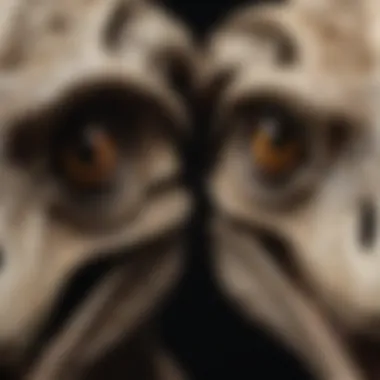

Key Features and Structures
The Velociraptor skull is notable for several key features that reflect its predatory lifestyle. Its elongated snout, sharp teeth, and large orbits reveal much about its predation strategies.
- Snout: The elongated shape aids in hunting, providing a streamlined profile that may have allowed for enhanced speed and agility.
- Teeth: The teeth are serrated. This suggests that the Velociraptor likely consumed small prey, tearing flesh with ease.
- Orbits: The large eye sockets indicate a strong reliance on vision. Such an adaptation would enhance its hunting capabilities in various environments.
- Cranial Fossa: The presence of a well-defined cranial fossa suggests that the Velociraptor possessed a complex brain, which implies advanced behaviors such as hunting in packs.
These anatomical features highlight the Velociraptor's role as an agile and effective predator. Replicas must carefully represent these elements to be valuable to collectors and educators.
Comparative Anatomy with Other Dinosaurs
When comparing the Velociraptor skull to those of other theropods, notably Tyrannosaurus rex and Allosaurus, some significant differences are evident. While all belong to the same group, the distinctions offer insights into evolutionary adaptations.
- Size and Shape: The Velociraptor skull is smaller and more delicate than those of larger theropods, indicating a different lifestyle focused on small or medium-sized prey.
- Jaws: Unlike the robust jaws of T. rex, the Velociraptor's jaws are designed for precision, suited for quick strikes rather than crushing.
- Cerebral Capacity: Velociraptor had a relatively large brain compared to its body size among theropods, suggesting more complex behaviors, including possibly social hunting.
The comparative anatomy not only provides perspective on the Velociraptor's ecological niche but also influences how replicas are crafted. Accurate representations inform collectors and educators about evolutionary progress and functional adaptations in different environments.
In summary, the anatomy of the Velociraptor skull is a window into its life, informing both paleontology and the world of collectibles. Knowing these key features and how they compare to other dinosaurs enriches an understanding that is essential for a thorough appreciation of these replicas.
By diving into the specific anatomical elements and the comparative characteristics, collectors gain a well-rounded view that boosts their engagement with the subject. This information can transform a basic display piece into a conversation starter rooted in scientific insight.
Production of Velociraptor Skull Replicas
The production of velociraptor skull replicas is a pivotal theme in understanding how these artifacts serve educational and collectible purposes. Replicas not only provide insight into the structure of these ancient creatures, but they also bridge the gap between science and art. Many who are interested in paleontology or collecting fossils appreciate the skill that goes into both creating these replicas and ensuring their accuracy.
Materials Used in Replication
The selection of materials for replicating velociraptor skulls can greatly influence the quality and realism of the finished product. High-quality resins are typically favored due to their durability and ability to capture fine details. Additionally, certain types of plastics can mimic the weight and texture of real bone, making the replica feel more authentic. Other common materials include:
- Polyurethane: This allows for a lightweight yet sturdy model.
- Fiberglass: Often used for larger displays due to its strength.
- Plaster: Useful for budget-friendly options but may lack durability.
The choice of materials is often driven by the intended use of the replica. For instance, educational institutions may prefer more durable materials that can withstand handling by students. Conversely, collectors might opt for more decorative pieces.
Manufacturing Techniques
Manufacturing techniques play an essential role in how accurately a velociraptor skull replica represents the original specimen. Different approaches yield varying levels of detail and fidelity.
3D Printing: One of the most innovative techniques in recent years has been the adoption of 3D printing. This method allows for high precision in replicating complex structures. Models can be created using scans of actual fossils, ensuring a level of accuracy that older methods may lack.
Molding and Casting: This traditional method involves creating a mold of an original specimen and then pouring materials like resin, plaster, or metal into the mold. This allows for the production of multiple identical replicas. However, it requires skilled artisans to ensure the details of the original skull are preserved in the mold.
Handcrafting: For some collectors and museums, handcrafted replicas are preferred for their uniqueness and artistic touch. Craftsmen often use a combination of techniques, meticulously carving and assembling parts by hand to mimic the original skull.
"The production of high-quality velociraptor skull replicas is an art form that requires understanding both the science behind paleontology and the craft of replication."
In summary, the production of velociraptor skull replicas is not merely a technical pursuit but also an integral part of preserving knowledge about these ancient creatures. From material selection to sophisticated manufacturing techniques, every detail matters, resulting in items that serve for education, display, or collection.
Educational Importance of Velociraptor Skull Replicas
Velociraptor skull replicas hold substantial educational significance, particularly in the fields of paleontology and natural history. They serve as tangible connections to the past, allowing students, educators, and enthusiasts to engage with dinosaur anatomy in an interactive manner. These replicas not only facilitate learning but also spark curiosity about prehistoric life and the evolutionary processes that shaped it.
Role in Paleontological Education
In paleontological education, the use of velociraptor skull replicas can enhance comprehension of complex anatomical structures. By examining a replica, learners can visually and physically grasp the features of the skull that indicate behaviors and adaptations of the velociraptor. For instance, students can study the size and shape of the skull, which provide insights into its predatory nature and feeding habits.
Furthermore, replicas serve as an important resource for classroom education, exhibitions, and field studies. By employing these models, educators can create interactive lessons that promote critical thinking. For example, discussions can revolve around hypotheses regarding the creature's lifestyle or theories about its extinction. This hands-on experience often leads to deeper understanding and retention of material.
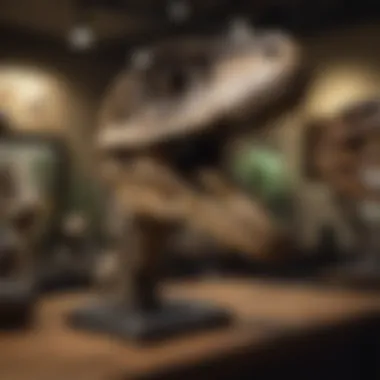
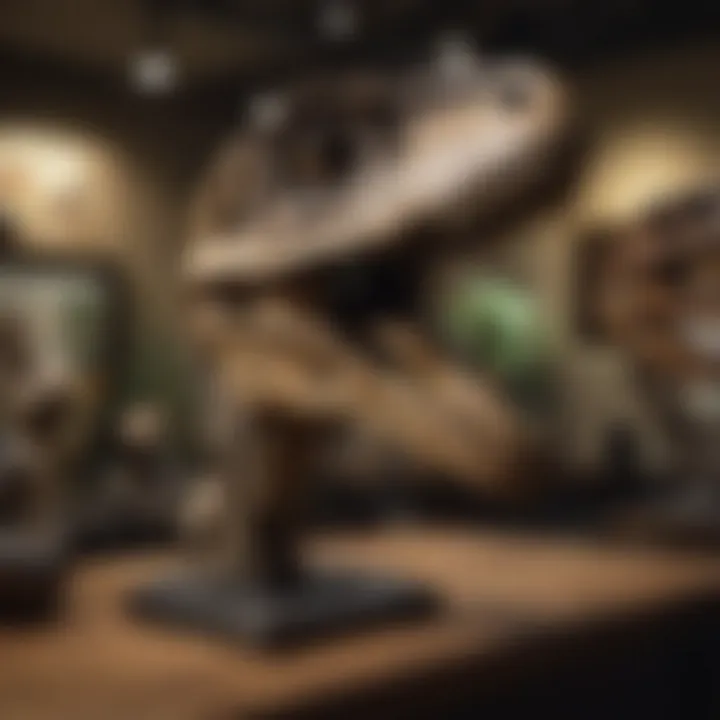
"Studying the skeletal structures of extinct species through replicas not only informs students about biology but also fosters skills in examination and inference."
Application in Museums and Exhibitions
Museums and exhibitions utilize velociraptor skull replicas effectively to attract and educate a broader audience. These settings benefit from displaying high-quality replicas that accurately represent the original fossils. Visitors can observe the replicas from various angles and distances, allowing for a comprehensive understanding of the skull's morphology.
When incorporated into exhibitions, replicas can tell a story. They offer an opportunity to connect past life forms with modern scientific research. For example, educational setups can include interactive displays where audiences can compare the velociraptor with other dinosaurs or creatures. Detailed plaques alongside replicas can provide critical information regarding paleontological discoveries and ongoing research in the field. Museums strive to make education accessible, and skull replicas serve as essential tools in this mission.
In summary, the educational importance of velociraptor skull replicas cannot be overstated. They play a pivotal role in teaching, allow for hands-on exploration of paleontological concepts, and contribute significantly to engaging exhibitions at educational institutions. Collectors and enthusiasts should recognize their value not just as collectibles but as instruments of learning.
Collecting Velociraptor Skull Replicas
Collecting velociraptor skull replicas represents a fascinating niche within the broader field of fossil and dinosaur-themed collectibles. Enthusiasts are drawn to these replicas for a variety of reasons. First, they serve as tangible connections to the ancient past, sparking curiosity about dinosaur behavior and biology. Furthermore, they are educational tools, providing insights into paleontology, evolution, and prehistoric life.
The importance of velociraptor skull replicas lies in their ability to bridge the gap between scientific knowledge and personal interest. For collectors, these replicas are not merely decorative items; they can also be a source of pride and a means of engaging with the community of like-minded individuals. As collectors acquire these items, they often develop a deeper appreciation for paleontological studies and engage in discussions about their significance.
Market Trends and Valuation
The market for velociraptor skull replicas has seen considerable evolution in recent years. Various factors influence pricing and availability, including the materials used, the craftsmanship involved, and the level of detail in the replica. High-quality replicas made from resin or polyurethane are often preferred due to their durability and realistic appearance.
Some current market trends include:
- Increased Popularity: As more people become fascinated with dinosaurs, demand for velociraptor skull replicas continues to rise.
- Diverse Offerings: Collectors notice an increase in variety, from life-sized replicas to smaller, more affordable versions.
- Sustainability Focus: Replicas created with eco-friendly materials are attracting environmentally conscious buyers.
Pricing for these replicas can range from moderate to quite high, depending on the factors mentioned. Collectors should be aware of their auction values and market trends to make informed purchasing decisions.
Tips for Aspiring Collectors
For individuals looking to start or expand their collection of velociraptor skull replicas, several considerations can help enhance their experience:
- Research Reputable Sellers: Access reliable online platforms such as eBay or dedicated fossil shops for trusted sellers.
- Attend Fossil Shows: These events offer excellent opportunities to connect with other collectors and find unique replicas.
- Join Online Communities: Engaging with forums on platforms like Reddit can provide valuable insights and tips from seasoned collectors.
- Verify Authenticity: Always request certificates of authenticity or documents that provide background information about the replica’s origin.
- Consider Display Options: Invest in proper display cases to protect the replicas from damage and dust while showcasing them effectively.
- Stay Informed: Continuously learn about both the scientific aspects of velociraptors and trends in the collectible market. Explore resources such as Wikipedia and Britannica for detailed information.
Collecting velociraptor skull replicas not only enriches your personal collection but also enhances your understanding of ancient life and paleontological significance.
Preservation and Care of Replicas
Preservation and care of velociraptor skull replicas are crucial for maintaining their integrity, appearance, and educational value. These replicas often serve as important tools for educating the public about paleontology and the fascinating world of dinosaurs. Proper care will ensure that these pieces remain in excellent condition for years to come, allowing collectors and institutions to showcase them without concerns about damage or degradation.
Handling Techniques
Handling a velociraptor skull replica requires attention and care. Here are some key techniques:
- Clean Hands: Always ensure your hands are clean and free of oils before touching a replica. This prevents the transfer of substances that can harm the surface.
- Gentle Grip: Use both hands to hold the skull. By supporting it from underneath, you reduce the risk of dropping or damaging it.
- Use Gloves: If possible, wear cotton gloves when handling the replica, especially for more delicate items. This adds an extra layer of protection against fingerprints and debris.
- Avoid Direct Sunlight: When moving the replica, avoid exposure to direct sunlight. Ultraviolet light can cause fading and deterioration over time.
"Proper handling of fossil replicas preserves their educational and aesthetic value, ensuring that they can be shared and appreciated by future generations."
Display and Storage Recommendations
The display and storage of velociraptor skull replicas should be planned thoughtfully. To keep them safe and visually appealing, consider the following recommendations:
- Display Cases: Use display cases made from glass or acrylic. This helps prevent dust accumulation and protects the skull from accidental contact.
- Away from Heat Sources: Position the display case away from heat sources and areas with fluctuating temperatures. It is vital to maintain a stable climate to prevent cracking or distortion of the material.
- Labeling: Clearly label the replica with relevant information such as species details and origin. This enhances educational value and context for viewers.
- Stable Shelving: If storing, ensure that the shelves are stable and can support the weight of the replica. Avoid overcrowding to reduce the risk of tipping.
- Regular Inspections: Periodically inspect your replicas for signs of damage or degradation. Early detection allows for timely interventions and repairs.
By implementing these preservation and care strategies, collectors and educators can maintain the significance and beauty of velociraptor skull replicas, benefiting both personal collections and public exhibitions.
Challenges in Replica Production
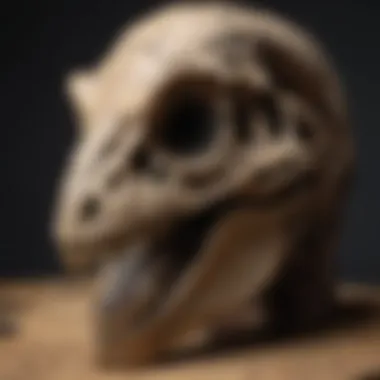
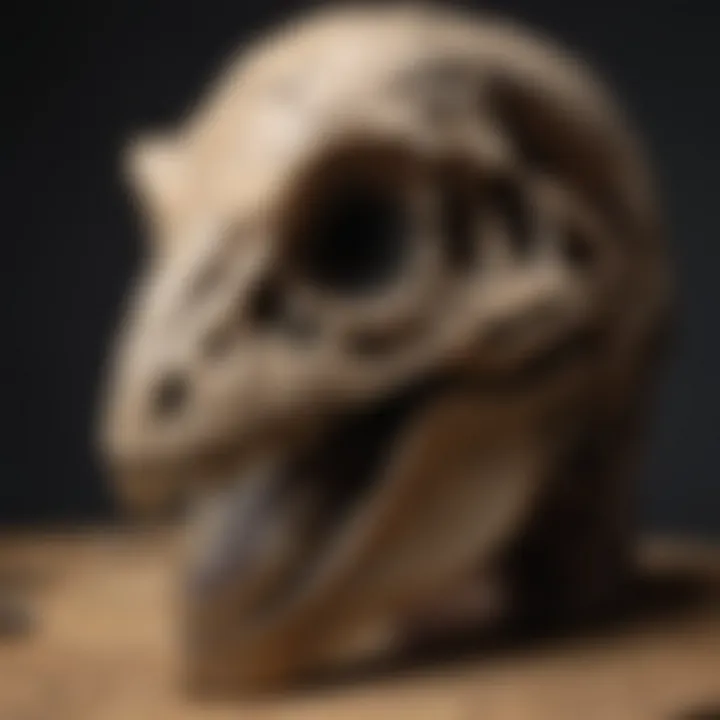
The production of velociraptor skull replicas involves navigating a myriad of challenges. These hurdles are crucial not only to the integrity of the replicas but also to their educational and aesthetic value. Achieving a balance between true-to-life accuracy and high-quality visual appeal is essential for educational purposes. Moreover, considering ethical implications adds another layer to the complexity of reproduction techniques.
Accuracy vs. Aesthetics
Accuracy in the replication of the velociraptor skull is paramount. Paleontologists and educators rely on precise reproductions to teach about the anatomy of this intriguing dinosaur. Any deviation from the original features can lead to misconceptions about its biology and behavior.
However, aesthetics also play an important role, particularly for collectors. Many replicas are intended for display. Thus, their visual attributes often take center stage. The challenge arises when striving to achieve a form that captures the essence of the original skull while also being visually appealing. A fine line exists between rendering a skull that is scientifically accurate but perhaps lacking in visual interest, and one that looks great but fails to represent the actual anatomical features accurately. Each choice in materials, colors, and finishes can affect both these aspects.
An example of this challenge is the creation of models that are too smoothed out or overly polished; while they may look appealing, they often misrepresent essential cranial structures. Thus, ensuring both qualities in a single product proves a notable challenge, demanding ingenuity from replica producers.
Ethical Considerations
The ethical considerations surrounding the production of velociraptor skull replicas cannot be overlooked. These aspects include the sourcing of materials, the authenticity of represented forms, and the potential implications of commercializing scientific replicas. Collectors may want to ensure that the replicas they acquire come from ethical producers who value educational integrity over mere profit.
Furthermore, the origin of the materials used in creating these replicas can raise ethical flags. For example, using materials that are sourced unsustainably could harm the environment. Ethical sourcing is a growing concern among today's collectors and producers alike.
"Understanding the implications of ethical production ensures that we honor the scientific significance of the fossils we emulate."
Lastly, it is critical to recognize the importance of intellectual property in the realm of fossil reproductions. Some companies may find themselves in legal or ethical trouble by producing replicas that imitate unique designs or specific research findings without permission. Therefore, navigating these ethical waters is essential for maintaining the reputation of both the industry and the community of collectors.
In summary, while creating high-quality velociraptor skull replicas, challenges such as merging accuracy with aesthetics and addressing ethical concerns remain vital issues. Addressing these problems with thoughtful solutions can enhance the understanding and appreciation of both science and art.
Future of Velociraptor Skull Replicas
The future of velociraptor skull replicas presents significant implications for paleontology, collecting, and education. As our understanding of fossils grows, so too does the capability to create more accurate and engaging replicas. This section will analyze two critical components influencing this evolution: technological advances in replication and the impact of digital resources on collecting.
Technological Advances in Replication
In recent years, the production of skull replicas has dramatically improved due to technological advancements. Innovations such as 3D printing, laser scanning, and high-definition imaging have transformed how replicas are made. These technologies allow for precise reproductions of the original fossil structures.
3D printing enables the creation of detailed models from digital files. This method involves scanning the original fossil to capture every intricate feature. The data is then used to print a replica, maintaining high fidelity to the original specimen. Likewise, laser scanning captures minute details of the fossil's surface, contributing to more accurate replica creation.
The development of materials has also played a role. Advances in polymer science have led to lighter, more durable materials that closely mimic the physical properties of bone. The combination of these factors enhances the aesthetic and educational value of the replicas. Collectors can expect replicas that not only look authentic but also stand the test of time.
Impact of Digital Resources on Collecting
The rise of digital resources has significantly changed the landscape for collectors of velociraptor skull replicas. Online platforms now offer extensive databases and marketplaces for fossils and replicas alike. This accessibility enhances the collector's ability to research and acquire pieces of interest from various regions and production methods.
Additionally, social media platforms, such as Reddit and Facebook, are creating communities where collectors can share insights and passion for fossils. These platforms facilitate dialogue about authenticity, valuation, and the significance of various replicas in a collection.
Moreover, digital technologies foster education. Museums and educational institutions are turning to virtual reality and augmented reality. These media allow individuals to interact with skull replicas and understand their structure in a three-dimensional space. Such tools can effectively engage younger audiences, making the world of paleontology more approachable.
"Digital tools open a realm of possibilities for collectors. The ability to visualize and interact with replicas adds depth to understanding fossils."
This future landscape holds promise for both enthusiasts and scholars. As technology develops further, the potential for realism and accessibility draws in new collectors, enriching the community and appreciation for these remarkable historical artifacts. The sustainable production and commercial availability of velociraptor skull replicas hinge on these advances and trends.
Ending
The importance of the conclusion within this article cannot be overstated. It serves as a final opportunity to summarize essential insights gained throughout the exploration of the velociraptor skull replica. Recapping key points consolidates understanding and emphasizes the relevance of this subject not only in paleontological study but also for collectors and educators alike.
In a world where technological advances shape the methods of bringing ancient beings back to life through replicas, it is crucial to recognize their value as educational tools. These replicas foster deeper engagement with the materials of paleontology and spark interest among a wider audience. Collectors also benefit significantly from understanding the nuances involved in the creation and preservation of velociraptor skull replicas.
Recap of Key Points
- Significance in Paleontology: The velociraptor skull replica is not merely an object of fascination. It plays a vital role in the understanding of dinosaur anatomy and behavior.
- Manufacturing Techniques: Knowledge about production processes—such as materials used and technological advancements—helps collectors make informed decisions.
- Educational Value: Replicas enhance learning experiences, notably within museum settings and academic environments.
- Market Trends: Recognizing current market dynamics and evaluating replicas can lead to better investment in collecting.
Encouragement for Enthusiasts
For those passionate about collecting or studying, engaging actively with velociraptor skull replicas presents an intriguing avenue for exploration. With the wealth of information discussed in this article, enthusiasts are equipped to deepen their appreciation for these artifacts. Whether you are a scholar, collector, or simply an admirer, investing time in understanding these replicas will undoubtedly enrich your journey.
The field is continuously evolving. Staying curious and informed is key to enjoying the complexities of paleontology and fossil collection. Explore, learn, and let your passion drive your adventures in this remarkable domain.



